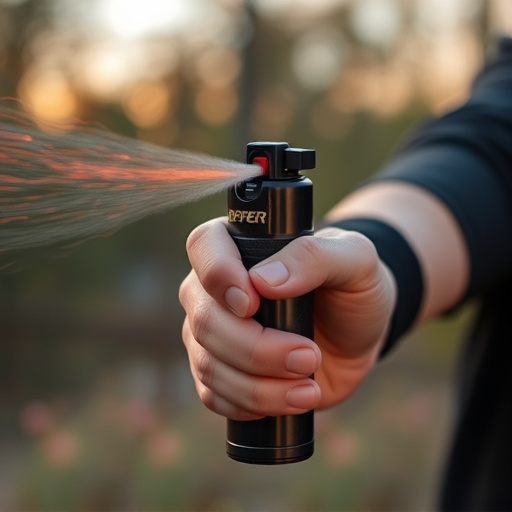Pepper spray defense training tips empower individuals to protect themselves in threatening situations without causing permanent harm. Effective training includes learning correct spraying techniques, understanding range and duration, practicing mock scenarios, staying fit, and knowing local laws. Responsible ownership involves regular maintenance, understanding legal implications, and adhering to guidelines for minimal impact and proportional response.
“Personal security is a growing concern in today’s diverse world. Non-lethal deterrent devices, such as pepper spray, offer a crucial layer of protection for individuals seeking to defend themselves. This comprehensive guide delves into the intricacies of non-lethal deterrents, focusing on pepper spray as a popular and effective option. We explore its effectiveness, provide essential training tips for defensive use, and discuss legal considerations surrounding personal security devices, ensuring responsible and informed usage.”
- Understanding Non-Lethal Deterrent Devices: An Overview
- Pepper Spray: A Common Non-Lethal Option and Its Effectiveness
- Training and Preparation: Essential Tips for Using Pepper Spray Defensively
- Legal Considerations and Responsible Use of Personal Security Devices
Understanding Non-Lethal Deterrent Devices: An Overview
Non-lethal deterrent devices, often carried for personal security, are designed to incapacitate or deter potential threats without causing permanent harm. These tools, including pepper spray, stun guns, and tasers, have become popular choices for self-defense. Pepper spray, in particular, is a widely used non-lethal option known for its ability to temporarily blind and disorient attackers, providing individuals with valuable time to escape or seek help.
Understanding how to use these devices effectively is crucial. Defense training tips can empower people to respond appropriately when faced with dangerous situations. For example, learning the right spraying technique with pepper spray, knowing the range of effectiveness, and understanding de-escalation strategies can significantly enhance personal safety. Such training ensures individuals are prepared not only to deter but also to navigate high-pressure encounters while minimizing harm.
Pepper Spray: A Common Non-Lethal Option and Its Effectiveness
Pepper spray is a popular and readily available non-lethal deterrent, often used as a personal security device. It’s a versatile option that can provide individuals with a powerful defense mechanism in various threatening situations. The active ingredient in pepper spray, capsaicin, causes temporary blindness, coughing, and difficulty breathing when sprayed onto the eyes, nose, or mouth of an attacker. This short-term impairment allows the user to escape and seek help, providing valuable time to assess the situation and take further action if necessary.
Effective use of pepper spray involves proper training and understanding its mechanics. Defense training tips include learning the correct spraying technique, such as aiming for the face and eyes, and being aware of the spray’s range and duration. Regular practice sessions can ensure individuals are prepared and confident in using this powerful tool responsibly. Additionally, staying informed about local laws and regulations regarding pepper spray ownership and use is essential to avoid legal repercussions and ensure its effectiveness as a personal security measure.
Training and Preparation: Essential Tips for Using Pepper Spray Defensively
Training and preparation are paramount when it comes to effectively using pepper spray defensively. Before considering any non-lethal deterrent, individuals should learn proper handling techniques specific to their device. This includes understanding the trigger mechanisms, range limitations, and safe storage practices. Engaging in mock scenarios with a trusted partner can significantly enhance user confidence and reflexive response time during an actual threat situation.
Beyond physical training, mental preparation is equally crucial. Practicing deep breathing exercises and visualization techniques can help maintain calmness under pressure, allowing users to make clear decisions while applying the spray. Staying physically fit enhances agility and endurance, which are valuable when confronted with a would-be assailant. Regularly reviewing safety protocols and staying informed about local self-defense laws further reinforces one’s ability to utilize pepper spray defensively in a legal and effective manner.
Legal Considerations and Responsible Use of Personal Security Devices
When considering a non-lethal deterrent for personal security, it’s crucial to understand the legal implications and responsibilities that come with owning and using such a device. Pepper spray, a popular choice, is governed by specific laws varying across jurisdictions. Users must be aware of their rights and the permitted use cases, as misuse or unauthorized deployment could lead to legal consequences. Responsible use includes proper handling, storage, and awareness of local regulations regarding self-defense tools.
Training tips for pepper spray defense should focus on safe application techniques, understanding the spray’s range and effects, and recognizing legal defenses against its use. It is essential to adhere to guidelines ensuring minimal impact on bystanders and proportional response to threats. Responsible ownership includes regular maintenance and expiration checks, as well as keeping records of usage to support self-defense claims if necessary.
In conclusion, non-lethal deterrent devices like pepper spray offer a crucial option for personal security. With proper understanding, training, and legal awareness, individuals can effectively utilize these tools for self-defense while minimizing harm. By following the outlined defense training tips, users can ensure their safety and gain valuable skills to navigate potentially dangerous situations. Remember, responsible use of personal security devices, including pepper spray, is key to a more secure and prepared lifestyle.
